What Does the 3 4 Gear Shift Fork in A94 Ford F150 5 Speed Standard Shift Transmission Look Like UPDATED
What Does the 3 4 Gear Shift Fork in A94 Ford F150 5 Speed Standard Shift Transmission Look Like

Contents
- Definitive Guide to Basics
- Foreword
- Base
- Mobility
- Gearbox Boogaloo
- Addendum
- Firepower
- Crew
- Troubleshooting
Definitive Guide to Nuts
Foreword
In essence, a guide to help you understand what things actually practise, and basic troubleshooting steps for your tanks.
It is worth mentioning that Sprocket is a very new game, and is likely going to get updated across this guide. This is mainly here to answer your mutual frequently asked questions.
Base
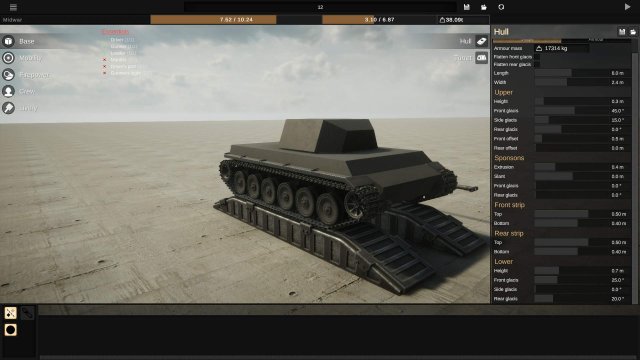
The base of operations tab is where you assemble the shape of your vehicle. Vehicle shape will bear on the overall interior space of the vehicle which will allow you to add together crew members equally well as ammunition and other internal components. A bulk of this is relatively straightforward and won't be described hither though. A larger tank will inherently be more massive though.
Mobility
Drivetrain
There are currently two types of drivetrain in Sprocket. A twin transmission driveline, and a clutch braking single driveline. Twin transmission uses two of the gearboxes you specify to drive the tank and the tracks at unlike speeds, which mostly allows for better performance on the move (typically) and allows the vehicle to perform a naught point turn. Clutch braking uses one transmission to bulldoze both sides of the tank, and so uses a clutch to stop one side of the tank from recieving ability, letting the vehicle turn. Clutch braking is less infinite and mass intensive, and more often than not works meliorate with weaker/less complex gearboxes.

The rail configuration of the vehicle itself if what allows your tank to move. At the moment of writing this, vehicles rely on their roadwheels to really grip the surface they are on. Equally a general dominion of thumb, more roadwheels will allow for more than traction, as will multiple larger roadwheels.
Belt
The Chugalug is the tracks themselves, and every bit far as I know, tracks are generally aesthetic at the moment. Track length and meridian appears to affect speed marginally and will make the tracks heavier overall. Width may not do annihilation as of yet, but we're even so ironing out what it actually does in game.
Sprocket
The sprocket itself is the critical piece of the tracks that actually drives the tank later your gearbox. As a general rule of pollex, a larger sprocket will deed as a type of gear, which will reduce the effective gearing ratio of the output you lot have fastened to the engine (meaning the engine will rev slower and potentially have a harder time spinning the tracks if geared poorly and/or underpowered for the vehicle), while a smaller sprocket will increment the effective ratio, simply bulldoze the tank slower overall (making it easier to rev out the engine, simply will also rotate the tracks equally a whole slower because a smaller gear rotates more to achieve the same amount of rails pulled). Optionally, you can identify the sprocket to the front or the rear, merely at the time of writing this, it is unknown (to me) what this actually effects in terms of vehicle performance.
Idler
Similar in role to the Sprocket, except this bike is placed opposite of the sprocket and mainly serves to ensure the tracks return to the vehicle properly. This can also exist increased or decreased in bore to serve as an effective gear type.
Roadwheels
The roadwheels on the tank are the function of the tank which interact with the terrain the well-nigh, and are supported with the vehicle pause. The roadwheels keep the tank level by using the suspension, as well as assistance the tank grip onto terrain (in theory). Mostly, larger roadwheels will tend to grip to surfaces amend than smaller roadwheels, but potentially run the risk of bogging down (which may not be simulated).
Return Wheels
Render wheels are an optional role of standard suspension and mandatory on HVSS designs. They return the tracks over the drive wheels instead of making them constantly in contact with the drive wheels themselves. This is currently doesn't practise much in terms of vehicle performance as far as i'm aware.
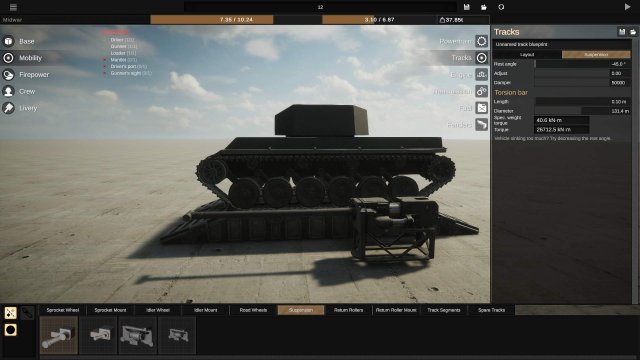
The suspension is in the procedure of being reworked, yet, I can offer some communication in the meantime.
If using a standard sprung pause, y'all will take what are called Torsion bars that adjoin the roadwheels on the reverse sides of the tank. These torsion bars concord the tank up, as well equally take and reduce the affect of terrain being rolled over. If using HVSS suspension notwithstanding, torsion bars practise not actually go underneath the tank, and instead the suspension is packed into a leap and damper unit of measurement above each pair of roadwheels with a set up torque value. Vehicle acme with HVSS is all-time determined by roadwheel height.
The rest bending is an essential office of standard suspension in Sprocket currently, equally information technology determines the angle the torsion bars flex when the vehicle is not under strain. Setting the value further negative volition allow the tank to sit down higher.
The damper counteracts the leap force interim to level out the tank after passing over terrain. If the tank is bouncing too much for your liking, you should increment the damper stiffness value. If the tank is jittering while not moving however, yous will probably want to reduce the damper stiffness.
Torsion Bars
The torsion bar length is in effect how long the torsion bar under the vehicle is. In general, a longer torsion bar will be less potent at resisting forces than a shorter torsion bar, simply a shorter torsion bar (in theory) would have much more express range of motion.
Torsion bar bore determines how thick the torsion bar is, which will brand the spring blazon significantly stiffer and more resistant to terrain undulation when made thicker. This comes at the toll of usually a significant space to the crew compartment however.
The Spec. Weight Torque section is how much mass the vehicle volition utilize to the break on it's ain equally a result of just existing. Y'all generally (in my opinion and experimentation) want this value to be one-half the value of your torsion bars rated torque value or less, else the tank will likely bottom out when passing over terrain.
Gearbox Boogaloo
Gearboxes and engines seem intimidating at offset, only they don't have to be once y'all sympathise the basics and the job of the gearbox. The gearbox and engine go together in well-nigh all vehicles and usually aren't too interchangeable unless the engines tend to have the same specs and become in similar enough vehicles.
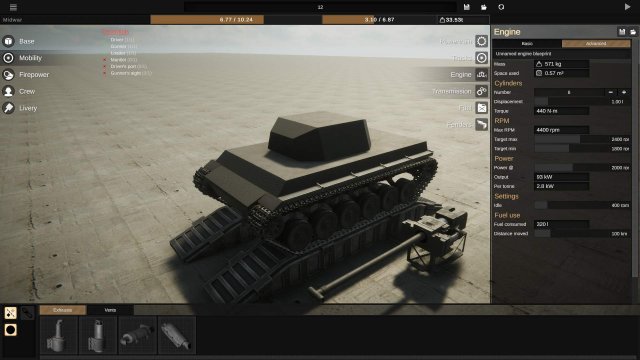
The engine is what really provides the power for you lot to move your vehicle. In that location are many possible solutions to designing an engine for your vehicle too, such as a small, high revving engine, or a large, slower engine that has more inherent ability at depression speed due to it's size generating more torque. Which blazon of engine you cull volition be dependent on multiple factors, including the gearbox in the next pace.
Cylinder Count and Displacement
These two tie together to make the engine you're going to place into the vehicle. Every bit a general dominion of thumb, larger engines will brand more than ability just be unable to rev college as the forces within the engine brainstorm to tear it apart.
Torque
Torque is the raw measurement of strength the engine can apply afterwards rotating 1 RPM. Torque is used in the math to determine overall engine ability, which is what is considered to actually move the vehicle.
RPM
RPM is how many times the engine volition complete a full revolution of the crankshaft, where a higher RPM indicates that the engine is spinning faster. Each engine has a Maximum RPM, or the maximum *safety* RPM. Exceeding the maximum RPM of the engine volition crusade damage to the engine, which will in turn somewhen cause the engine to explode, burn down, and impale the crew of your tank.
Max and Minimum RPM target
The minimum and maximum RPM targets will tell the AI at what point to do actions which will handle the gearbox to keep the engine at the specified target ranges.
Maximum RPM generally should be kept at, or around 200 RPM below the actual maximum rated RPM of the engine, as exceeding the rated max is usually very bad, for reasons mentioned above.
Minimum RPM should be set to a value so that the tank can really gain speed at the lowest gear with the RPM you set. This will keep the tank moving, as the coiffure will endeavor to launch the tank and steer the tank (with twin transmission drivetrains) as this set up RPM instead of the idle RPM of the engine.
Idle RPM is the speed at which the engine idles when the tank is in neutral, or otherwise not driving. Mostly this isn't that important of a thing to care virtually unless yous intendance about fuel economy.
Ability @ Slider
The Power @ slider is a tool you tin can use to run into how much power the engine you have will produce at a set RPM. Using this, you lot can determine the power that the vehicle makes at certian engine speeds, and work to make a gearbox that works well with the engine. More often than not, yous should pay attention to the power to weight ratio, where higher values are usually better. If your tank has a higher power to weight ratio (+10 HP/t) at lower speeds, chances are you won't need a large reduction gear to get moving. if your engine is particularly weak nevertheless (~2-v HP/t) you usually will need a large gearing reduction to fifty-fifty get the vehicle to move.
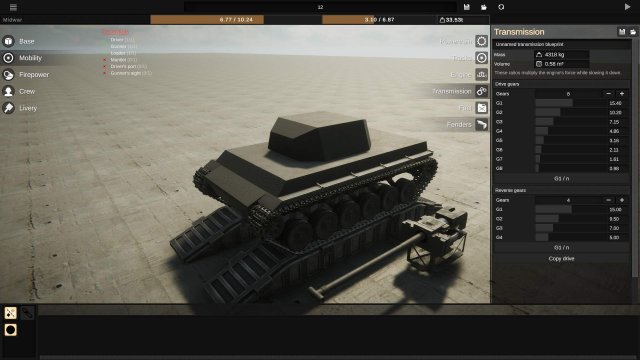
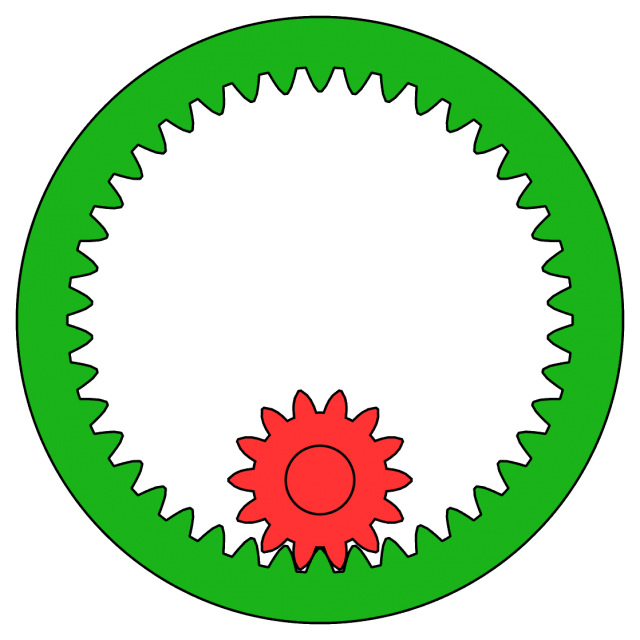
This is a (planetary) gear. A 3.5:1 ratio gear in fact (you can make this by typing 3.v into the value for the gear). The job of a gear is to allow the vehicle or engine to exist able to run a vehicle at a certain speed without causing the engine to stall pushing a forcefulness higher than what it can handle. In effect a gear allows a vehicle to keep it'south engine momentum moving, else it will stall. This is particularly relevant at depression speeds, where the engine will tend to fight against the rolling resistance of a vehicle. The solution to this is by adding a "reduction gear", such equally is the instance in this above image. Assuming the larger green gear is tied to the sprocket, and the smaller red gear is the engine, you will see that for every i fourth dimension the greenish gear rotates, the red gear spins three and a half times. This is useful to actually go the tank moving, if a chip slowly, and generally keeps the engine from stalling.
Setting upwards ratios on your tank should be determined by a few simple things to go you started, and we'll assume the engine does not modify on your tank.
- If the vehicle is having a hard time getting moving, but not exceeding the rev limiter, gear up your gear value to a higher number, that way the engine will be able to get more revolutions in, and put down a flake more power.
- If your engine is constantly overrevving, yous should gear up the ratios lower so the gearing doesn't endeavour to impale the engine.
- When shifting gears, you want to ensure that the engine can autumn within the RPM range y'all desire out of the new gear, otherwise the crew AI will get confused and terminate upwardly (in most cases) shifting into first gear permanently, shifting between the gears rapidly and stalling the tank, or shift to the last gear and not move.
- Large reduction gears tend to get very large, often to the point that it'southward typically better to but opt for a better engine, over using massive gearing reductions.
Addendum
The driver AI entirely uses engine RPM to determine where and when to shift. Ane major matter I noticed is that the suspension configuration on the tank can cause the tank to rock back and along under dispatch if likewise stiff or too soft, causing the engine RPM to fasten and trough causing the AI to shift improperly. Use the V central to see what RPM your engine is at in the bottom graph in real fourth dimension, with the min and max targets set, and the superlative graph volition show what gear the tank is driving in.
If your tank has a zigzagging RPM on the real time graph of a significant amount, yous should alter your suspension. If the tank is rocking frontward and backwards, by and large you want to increase damping. If the tank is rocking softly with damping still applied, y'all may want to strengthen the torsion bars and reduce damping. Every tank is going to be different, with different sizes and engines and top speeds, yet this is something to keep in mind if the tank is driving unusually.
Firepower

The cannon is the master armament of your tank in Sprocket. Designing them is relatively straightforwards.
Cannon Dimensions
Cannon base and butt both contribute to the length of the entire gun. In general, making the barrels thicker doesn't really do anything meaningful at this point in the game except for potentially hide weaker armor behind/in the gun mantlet.
Caliber and Shot Length
The gun caliber and shot length determine how big the bodily projectile is, and will make up one's mind how fast the shot flies, and how much harm it volition do to a target. In general a larger projectile volition have more penetration, provided the gun is long plenty to allow the shot to hit it's maximum velocity (which is currently capped past era).
Rules Of Thumb
- Longer barrels offer more accuracy and shot speed (up to a point)
- Longer barrels, and more than thick barrels are heavier and harder for the turret to aim.
- Penetration reaches it'due south max once the shot reaches maximum velocity for the era.
Coiffure
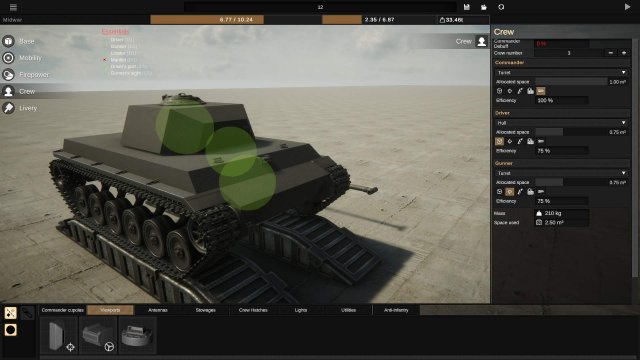
The crew are who operate the tank. Each crewman (excepting the loader and radio operator) need a sight in order to perform their office, and placement of internal components volition change where the crew is seated.
Commander
An optional tank role that increases the perfomance of the crew. A tank without a comander will practice everything 50% worse, and a tank with an overloaded commander will do tasks somewhat worse. Will sit down nether the commander cupoula position.
Gunner
Required to actually aim and fire the gun. The gunner will be placed behind the gunner sight, and allow the player, or the AI tanks to accept shots at enemy vehicles. Efficiency losses include a reduced turret traverse speed and reduced gun elevation speed. Must have the sight installed on the aforementioned part of the structure as the gun.
Loader
Also required to fire the gun. The loader mostly sits somewhere behind the gun to one side of information technology. Reduced loader efficiency will slow downward the reload charge per unit of the cannon.
Commuter
Sits behind the drivers viewport and drives the tank. Overloaded drivers will cause the tank to shift slower and generally perform worse.
Radio Operator
Doesn't accept a dedicated position as far as I can tell. Requires an antenna on the tank, and allows the actor to issue orders to friendly AI tanks. No apparent efficiency problems.
Troubleshooting
Gun Won't Shoot or Aim
Make sure you have a sailor with the gunner and loader role, both in the same location of the gun (turret for turreted tanks, hull otherwise).
Engine Keeps Exploding
Use less reduction gearing. In other words, type in lower gearing values for the gearbox until the engine stops exploding.
Tank Moves Extremely Slowly
Odds are that yous have the opposite issue of to a higher place. Use more aggressive gearing if you want the tank to accelerate.
Gun won't drag but volition shoot
Odds are that the gun is too heavy/large for the corporeality of force y'all applied to the cannon. Reducing the weight of the cannon past reducing butt thickness, and length can help alleviate this.
Tank is stuck on the basis
In full general, you want your tank to have footing clearance, and sometimes at that place are some cases in which the tank direct up gets stuck. I manner to alleviate these problems is to set up a higher negative resting angle for the torsion bars, and increase the diameter of the bars. For HVSS tanks, you will usually want to add together a negative elevation offset to them so that the wheels are spaced abroad from the hull.
W.I.P.
Recommended for You
DOWNLOAD HERE
What Does the 3 4 Gear Shift Fork in A94 Ford F150 5 Speed Standard Shift Transmission Look Like UPDATED
Posted by: stephaniehasto1955.blogspot.com
Comments
Post a Comment